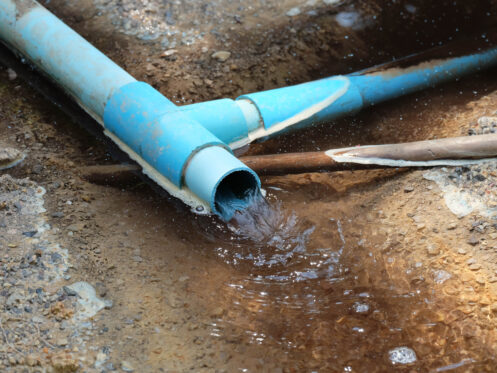Your outdoor drains have the all-important job of routing snowmelt, rain, and wastewater away from your home and its foundation. There are multiple drain types and styles that builders and plumbers use, and each comes with its own range of potential problems.
You’ll know when you have outdoor drain issues when you have soft, spongy ground, back flowing water, pooling water, or pervasive drain odors. The following is everything you need to know about dealing with broken or low-performing drains outside your Stafford, VA home.
Landscape Drains
Landscape drains are outdoor drains that route water away from building foundations. During times of heavy precipitation, stormwater must have a place to go. This includes all of the water that directly lands on the ground as well as stormwater that flows through your gutters and downspouts. Without adequate grading and landscape drainage, your property could develop problems with driveway, sidewalk, and soil erosion.
Dry Wells for Drainage
Many homes throughout the region have simple dry wells for drainage. These drains funnel water into natural wells where they slowly percolate into the surrounding soil. If you have overflowing dry wells, your land may need grading refinements or an additional or alternative drainage type. You can have one of our plumbers inspect your dry wells or hire a grading specialist.
French Drains
French drains are perforated, submerged pipes that are installed in gravel-filled trenches directly abutting homes. French drains route water away from building foundations to prevent basement leaks, foundation cracks, and other problems.
Even when wrapped in protective geotextile fibers, French drains aren’t impervious to encroachment. Geotextile wrappings and the pipes they protect can be overrun by invasive weeds and tree roots. These growths clog pipe interiors and inhibit the movement of water. When this happens, water pools at designated collection points and seeps into foundations when local soils are saturated.
Although submerged in loose gravel, French drains are also vulnerable to damages. Moving heavy lawn equipment or even simply walking over these drains could compress their plastic, corrugated pipes. If you have pooling water near your French drains, it’s best to call a plumber.
Catch Basins and Sump Pumps
For homes with massive amounts of runoff and moist, quickly saturated soils, builders and plumbers often install catch basins. Catch basins collect runoff and direct it to a sump pump or to another reservoir that’s connected to a sump pump. Catch basins can experience problems like collapsed pipes, pipe clogs, and the erosion of nearby or supporting asphalt structures.
When working in tandem with sump pumps to prevent flooding, catch basins are also prone to developing secondary issues resulting from poor sump pump performance or failure. You might have a sump pump that isn’t properly rated for your needs, an improperly installed sump pump, or clogged discharge lines, switches, or inlet screens.
Given the complex nature of these setups, attempting do-it-yourself repairs could result in multiple failed attempts and lots of unnecessary spending. A plumber can accurately diagnose the issue and provide the necessary solution.
Sewer Line Problems and Widespread Drain Issues
All of the drains inside of your home converge onto a single outdoor sewer line. This underground pipe travels from your home to the municipal sewer system where it deposits all of the liquid waste your household produces. If your sewer line is ever blocked, crushed, or cracked, your indoor drains will stop working. Worse still, if the problem isn’t identified and resolved right away, solid waste and wastewater will come rushing back into your home.
Your outdoor drain clean-out provides direct access to your home’s main sewer line. It is through this entry point that plumbers perform drain and sewer line cleaning. If you have multiple blocked, slow-moving, or malodorous drains throughout your home, this is among the first plumbing features that plumbers will inspect.
Common Sewer Line Problems
Like all plumbing components, sewer lines sustain ongoing, age-related wear and thus, they can crack or collapse over time. However, just like French drains, these features can also be encroached upon by aggressive weeds and tree roots.
When residents flush heavy, solid, or slow-degrading items, these products may get caught up on weed or tree root intrusions or snagged on increasingly rough pipe interiors. Sewer line blockages can also occur as the result of advanced pipe corrosion or tacky buildups of grease, soap scum, hair, and other soft, semi-solid materials.
The Top Drain and Sewer Line Cleaning Methods
Performed at the drain clean-out, hydro-jetting uses forceful jets of hot water to break down obstructions and push them out of the plumbing system. For older pipes with advanced wear, hydro-steaming offers similar results but uses hot, high-pressure steam instead. Our plumbers can additionally use mechanical drain cleaning measures such as drain snaking to break up tough, stubborn obstructions that aren’t responsive to less invasive techniques.
We proudly serve Stafford, VA with superior plumbing, drain cleaning, and water heater services. We also provide gas line, main water line, and sewer line services. For help with your outdoor drain issues, contact Smooth Plumbing now.

